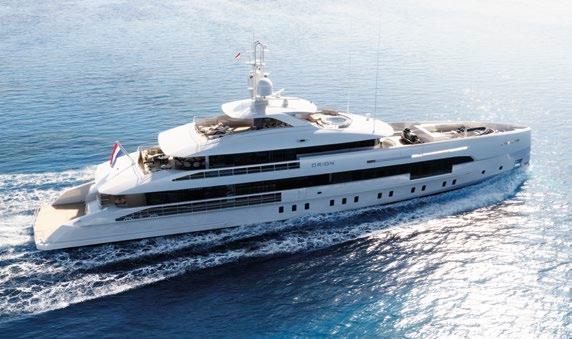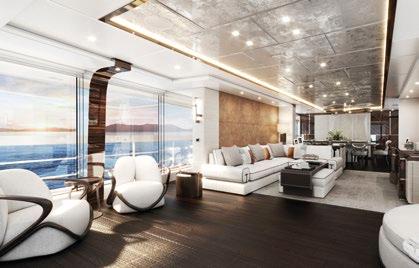
4 minute read
THREE OF A KIND
TEXT BY JUSTIN RATCLIFFE
Heesen’s speculative construction strategy has proved successful time and again, especially during times like these, when demand is high and build slots are in short supply. It’s an approach that saves customers both money and time.
Fantastic features – Project Orion
Orion is the third hull in Heesen’s 50-metre FDHF hybrid series, with exterior design by Omega Architects. Built of aluminium with a sub-500GT volume and shallow draft, she is designed to offer the ultimate in quiet, fuelefficient cruising. She is available for sale with delivery in February 2025.
“There are so many fantastic features on this all-aluminium, Fast Displacement yacht that it’s hard to know where to start,” says Mark Cavendish, executive commercial officer at the shipyard. ”The exterior design is über-cool, with long, crisp lines and a near-vertical bow, and the contemporary interior styling by Italian designer Cristiano Gatto is a perfect much for the exterior lines. She’s also one of very few yachts in her size range with six cabins: the master on the main deck forward, a full-beam VIP and four guest staterooms on the lower deck – a draw for both private use and charter.
“But I think the biggest plus of this project goes back to the initial design concept, which was to create what is one of the most efficient yacht in its class. To start, you have the lightweight aluminium construction and Fast Displacement Hull Form. This means she can be powered by twin MTU engines of just 600kW each for a top speed of 16 knots, where a conventional steel-hulled displacement yacht would need a pair of 1,000kW engines. At 12 knots, she will burn 98 litres per hour, excluding hotel loads, for a range of 3,750 nautical miles. That translates into around 40 per cent less power and 25 percent less fuel for the same range, which for a 50-metre yacht displacing 295 tons is an outstanding achievement.
“And last but certainly not least, there’s the hybrid propulsion. There are four different modes, including the opportunity to cruise silently using just the generators. But in hybrid mode at 10 knots consumption drops to a mere 45 litres per hour. I don’t know of another 50-metre yacht with those kinds of consumption figures.”
Fits like a glove – Project Venus Venus is the eighth hull in Heesen’s successful 55-metre Steel series, and the third with the newly restyled exterior lines by Omega Architects. These new design elements also include a fixed French balcony in the master stateroom, separate crew access to the sundeck, and continuous sheets of thermo-bonded exterior glass on the main deck. The yacht is available for delivery in Spring 2025.
“This is a design that complements the Heesen range of series yachts so well, and fits the brand like a glove,” says Heesen’s CCO, Mark Cavendish. “The price per gross ton is extremely competitive, and I would argue that you won’t find a spec yacht of north European build with the same dimensions, features and quality. In fact, at 760GT she offers a lot more volume than a
50-metre yacht, but not much less in terms of onboard experience and amenities compared to a 60-metre. That’s an important consideration and one reason why the concept performs so well as a charter yacht.

“The layout is another attraction, with four guest cabins on the lower deck, the master stateroom on main deck and a VIP suite on the bridge deck. This is a boon for clients interested in charter, but also Middle Eastern clients who like to have a lot of cabins. The choice of Luca Dini for the interor styling was inspired, and he really brings additional pedigree to the game, which is something we’re always keen to emphasise.
“Not forgetting the Fast Displacement Hull Form, for improved performance and fuel efficiency, without sacrificing the comfort and seakeeping of a full displacement yacht. Her two
MTU engines provide a top speed of 15.5 knots and a transatlantic range of 4,500 nautical miles at a cruising speed of 13 knots.
“Heesen pioneered the on-spec construction of superyachts in the 2000s, and as the latest in our 55-metre Steel series, Project Venus highlights how we’ve mastered the art of series-building superyachts based on proven engineering platforms that are continuously fine-tuned.”
Fast but efficient – Project Jade
Project Jade is the third yacht in Heesen’s 50-metre fast-cruising class, and the first of its kind below 500GT to comply with IMO Tier-III regulations. The sporty exterior design is by Omega Architects and the shipyard chose once again to work with Cristiano Gatto on the interior styling. Project Jade is available for delivery in April 2024.
“Project Jade and the 50-metre fast-cruising series is an evolution of our very popular semi-displacement model that began with ‘Satori’, of which we sold eight examples,” says Heesen sales director Robert Drontmann. “The current design was partly driven by the need to comply with the Tier III Class rules that require big and bulky Selective Catalytic
Reduction (SCR) units on the engines to filter out harmful exhaust emissions. The result was a complete redesign from top to bottom, including the hull, to allow for extra space in the engine room without detracting from the guest areas.
“Our engineering team developed an optimised, low-drag hull with a reduced transom depth for a shallow shaft angle, which makes Jade comfortable on longer passages, and in rough seas, but she is also perfect for island-hopping in the shallow waters of the Bahamas, for example. The ultra-efficient hull shape basically offers the same performance as the previous iteration but with smaller engines, reduced fuel consumption and lower emissions.
“Omega styled a gently curved superstructure for a sleeker aft end and we created a multipurpose beach club that doubles as a tender garage. Usually on yachts of this kind you have to take a few steps down into the beach club, which means you lose the views and intimate contact with the sea. But on Jade, when the tender is launched and the transom hatch deployed, the whole area is on the same level, which makes all the difference.”
INTERVIEW: JASPER SMIT, EYSING



